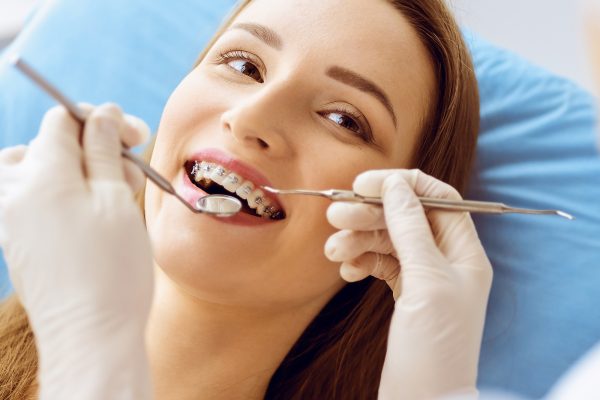Orthodontic Care
Caring for Braces
You will be provided explicit and clear details and instructions on caring for your braces when your treatment begins.
You must remember to properly clean your mouth before and after you eat, as braces can easily trap food, which can damage your enamel and even lead to gum disease.

Be sure to brush your teeth 4-5 times per day, at minimum:
- Brush back, forth, and across – between the wires and gums.
- Then brush as if you would without braces on
- Start on your upper teeth, and scrub in a circular motion. 2 or three teeth at a time, for about 10 strokes before moving on.
- Repeat the process for the inner surfaces
- Repeat the steps for the bottom teeth
- Be sure to check in the mirror for any food particles you may have missed
Note: Do not avoid brushing if you notice bleeding – but rather continue stimulating the area with the bristles. Be sure to angle your toothbrush so that the area under your gum line is cleaned. After 3 or 4 days of proper brushing, the bleeding should stop and your gums should be healthy again.
FLOSSING: Use a special floss threader to floss with your braces on. Be sure to floss at least once per day.
FLUORIDE RINSE OR GEL: May be recommended for preventive measures.
Appliance Care
Your retainer can be cleaned by brushing it with toothpaste. Always place the retainer in its plastic case when not in use. Do not wrap it in any paper product, as someone could accidentally throw it away. Do not put it into your pocket, or leave it in excessive heat – these practices could result in extreme damage to the appliance.
Elastics Care
Eslastics ‘shock’ the teeth and may cause soreness if they are worn intermittently. Soreness can be an indication of improper use of the appliances – or poor hygiene. Elastics should be worn correctly, and we’re happy to give you a refresher if necessary.
Proper Diet
|
Avoid Sticky Foods, Including but Not Limited to:
Caramels
Candy bars
Fruit Snacks
Gum
Candy Apples
Hard or Chewy Candy |
Avoid Hard or Tough Foods, Including but Not Limited to:
Pizza Crusts
Nuts
Candy
Chips
Ice Cubes
Bagels
Popcorn Kernels |
The following foods can be cut up and chewed with your back teeth:
Apples
Carrots
Corn on the Cob
Pizza
Pears
Celery
Chicken Wings
Spare Ribs |

















